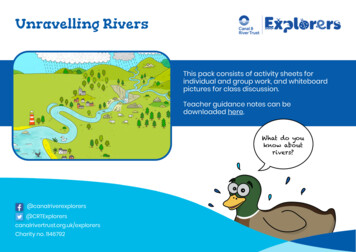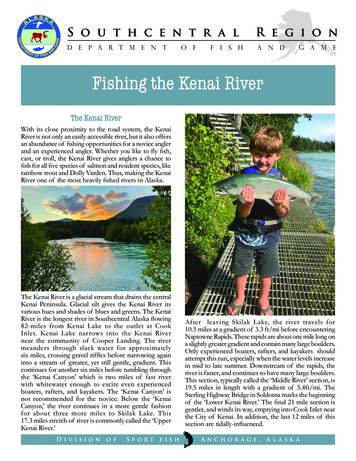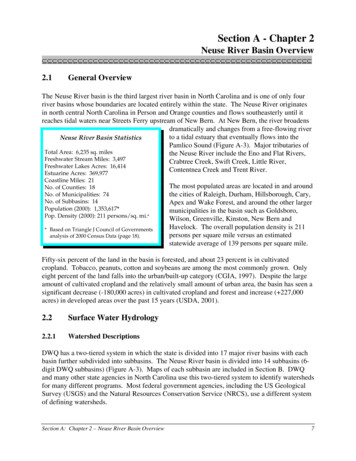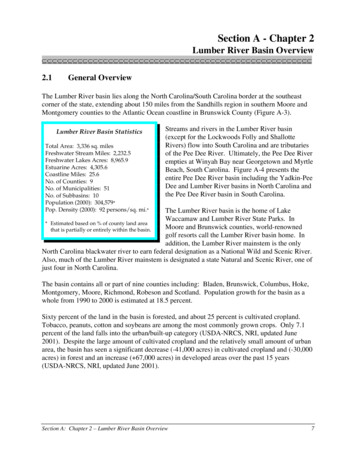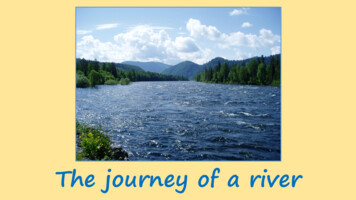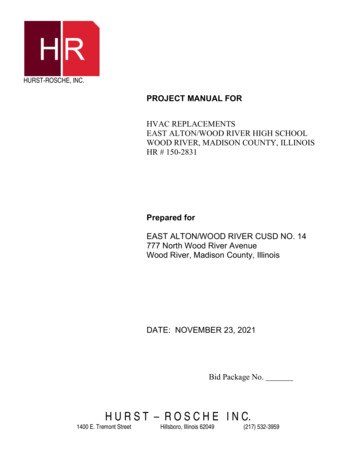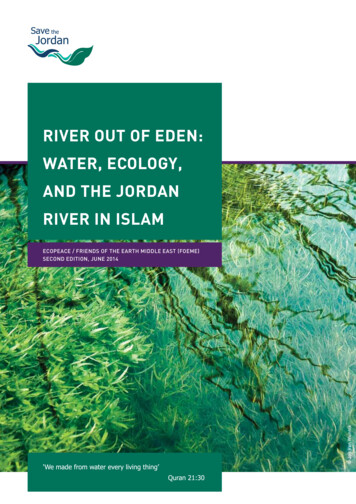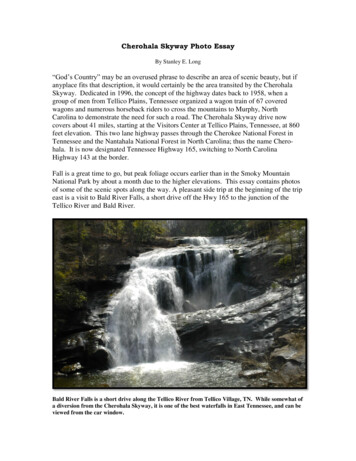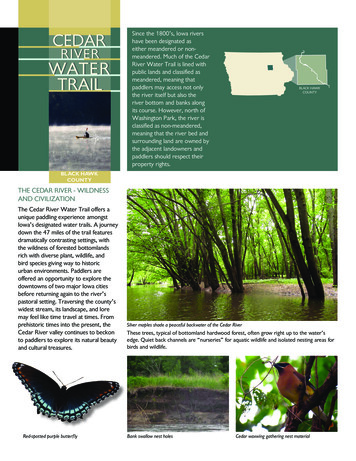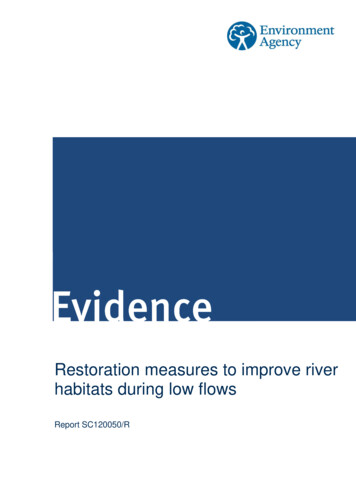
Transcription
Restoration measures to improve riverhabitats during low flowsReport SC120050/R
We are the Environment Agency. We protect and improve theenvironment and make it a better place for people and wildlife.We operate at the place where environmental change has itsgreatest impact on people’s lives. We reduce the risks to people andproperties from flooding; make sure there is enough water for peopleand wildlife; protect and improve air, land and water quality andapply the environmental standards within which industry canoperate.Acting to reduce climate change and helping people and wildlifeadapt to its consequences are at the heart of all that we do.We cannot do this alone. We work closely with a wide range ofpartners including government, business, local authorities, otheragencies, civil society groups and the communities we serve.This report is the result of research commissioned and funded bythe Environment Agency.Published by:Environment Agency, Horizon House, Deanery Road,Bristol, BS1 5AHAuthor(s):Sebastian Bentley, Judy England, Claire Bithell, DavidMould, Helen tagencyDissemination Status:Publicly availableISBN: 978-1-84911-382-3Keywords:Geomorphology, hydromorphology, ecology, habitat,restoration, modelling, typology, scale Environment Agency – September 2016All rights reserved. This document may be reproducedwith prior permission of the Environment Agency.The views and statements expressed in this report arethose of the author alone. The views or statementsexpressed in this publication do not necessarilyrepresent the views of the Environment Agency and theEnvironment Agency cannot accept any responsibility forsuch views or statements.Research Contractor:JBA ConsultingThe Library, St Philip’s Courtyard, Church Hill,Coleshill, B46 3AD01675 437750Environment Agency’s Project Manager:Judy England, Evidence DirectorateFurther copies of this report are available from ourpublications catalogue:www.gov.uk/government/publicationsor our National Customer Contact Centre:T: 03708 506506Email: enquiries@environment-agency.gov.ukiiRestoration measures to improve river habitats during low flows
Evidence at theEnvironment AgencyEvidence underpins the work of the Environment Agency. It provides an up-to-dateunderstanding of the world about us, helps us to develop tools and techniques tomonitor and manage our environment as efficiently and effectively as possible. It alsohelps us to understand how the environment is changing and to identify what the futurepressures may be.The work of the Environment Agency’s Evidence Directorate is a key ingredient in thepartnership between research, guidance and operations that enables the EnvironmentAgency to protect and restore our environment.This report was produced by the Scientific and Evidence Services team withinEvidence. The team focuses on four main areas of activity: Setting the agenda, by providing the evidence for decisions; Maintaining scientific credibility, by ensuring that our programmes andprojects are fit for purpose and executed according to international standards; Carrying out research, either by contracting it out to research organisationsand consultancies or by doing it ourselves; Delivering information, advice, tools and techniques, by makingappropriate products available.Miranda KavanaghDirector of EvidenceRestoration measures to improve river habitats during low flowsiii
Executive summaryThe requirement to achieve good ecological status in rivers, along with the potentialimpacts from climatic change, has emphasised the need for the Environment Agency tohave a better understanding of the dynamic nature of catchments for river basinplanning, targeting improvement measures and preventing deterioration in ecologicalquality.Physical modification was reported in the first river basin management plans as one ofthe top 3 reasons why water bodies are not currently at good ecological status.Restoring natural river processes at various scales will be required to meet WaterFramework Directive objectives. Improving the current condition of rivers will alsoimprove resilience to future pressures like climate change.River channels need to be able to accommodate floods and to provide good qualityhabitats at low flow conditions. Ecological communities in modified channels are knownto be less resilient to low flows. Improving the morphological condition of river channelsis likely to increase ecological adaptive capacity and resilience to future changes.However, a lack of effective monitoring and reporting of the impacts of river restorationmeans that understanding of the performance of many restoration measures under lowflow conditions is inconclusive or absent.To help address this knowledge gap, the Environment Agency has carried out amodelling study to generate information about how some potentially useful measuresmight improve in-channel habitats during low flows while also being robust to highflows.Following a review of previously reported assessments and case studies, 5 restorationmeasures were selected for further study: assisted natural recovery; embankmentremoval; weir removal; re-meandering; and reconnection of an old palaeochannel.Information from light detection and ranging (LiDAR) and aerial imagery was used tocreate digital elevation models on which hydraulic models could be run to definehydraulic habitat patches (areas of different velocities) and compare restorationmeasures with control sections (either degraded sections on the same watercourse, orpre restoration conditions). The approaches were tested in real river locations wherethe measures had previously been implemented and, in one case, to assess the likelyeffects of implementation.A further objective was to determine whether the findings would apply to otherlocations. To do this the river type for each case study was classified. Seven broadcategories of river types were identified based on existing classifications in useelsewhere. These provide a high level framework for considering whether measureswere likely to be effective in different river types and where benefits would not berealised.Main findings from the case studies Assisted natural recovery was successful in restoring hydromorphologicalprocesses. It increased hydraulic habitat diversity and habitat connectivity,and created flowing water refugia under low flow conditions. Thisdemonstrated that it was a suitable measure to increase ecologicalresilience in wandering rivers. Modelling the impact of flood embankment removal in a wandering river didnot result in any change in habitat provision under low flow conditions. Thisis likely to be due to the bank protection continuing to constrain the channelivRestoration measures to improve river habitats during low flows
and emphasises the importance of restoring geomorphic processes as wellas changing channel form. Weir removal in an active single thread system restoredhydromorphological processes and increased the presence of faster flowingbiotopes and habitat diversity under low flow conditions. This demonstratedthat weir removal is a suitable measure to increase ecological resilienceand also improve longitudinal connectivity. The re-meandering of a low energy, passive single thread river did notincrease habitat diversity or create flowing water refugia under low flowconditions. Meandering and increasing channel length within low energysystems is unlikely to increase ecological resilience under low flows. It islikely to be more successful in more active systems. The palaeochannel reconnection in an active single thread river typeshowed no observable change in habitat under low flow conditions in theshort term. Reconnecting channels in active systems, which are allowed toadjust, have the potential to increase ecological resilience at low flows overtime.Conclusions and recommendationsThe case study assessments demonstrated the importance of the correct identificationof the river type (forms and processes) when selecting suitable restoration measures toimprove habitat conditions under low flows and to ensure they remain functional andsustainable in the short and long term. Restoring hydromorphological processes iscrucial in increasing the sustainability of schemes, and greatly influences the rate ofchannel response and timescales of recovery or improvement in the affected habitat.The modelling approach used in this study can help to evaluate potential impacts onlarge sections of river in a cost-effective way and at a high resolution. Modelling can beused to help to identify suitable locations for restoration and to evaluate potentialsuccess without having to conduct resource-intensive field studies, though these mayhelp to validate model results.A matrix was developed to summarise current understanding about the effectiveness ofa range of restoration measures and how well they might work in a range of river typesor locations. This is based partly on expert judgement but, where relevant studiesexisted, it was possible to provide greater confidence in the assessment. Confidenceassessments can be updated as more information becomes available, particularlyabout how river ecosystems respond to hydromorphological change over time.The review of current understanding indicates low confidence in the effectiveness ofseveral measures and evidence gaps for: assessments of catchment scale measures the application of measures in higher energy systems long-term impactsFurther targeted studies would help to improve understanding of how plants andanimals respond to hydromorphological measures. Greater confidence in theeffectiveness of restoration measures may support their wider uptake and lead to betterenvironmental outcomes.Restoration measures to improve river habitats during low flowsv
d91.31.4Project aimsReport structure10102Methods112.12.2Identification of morphological measuresSelection of case studies11122.3Modelling methodology142.4Development of a matrix for targeting measures153Review of morphological measures174Case study assessments304.1Assisted natural recovery in a wandering river304.2Flood bank removal in a wandering river384.3Weir removal in a wandering river434.44.5Re-meandering of a passive single thread riverPalaeochannel reconnection in an active single thread river51594.6Discussion655Guide to selecting restoration measures675.1About the ist of abbreviations83Appendices84Table 2.1Table 3.1Table 4.1Table 4.2Table 4.3Table 4.4Table 4.5Table 4.6Table 5.2Table 5.1Hydraulic biotopesReview of restoration measures to improve river habitats during low flowsSelected case studiesReview of refugia available under bankfull conditionsReview of refugia available under bankfull conditionsRefugia availability under bankfull conditionsRefugia availability under bankfull conditions for the Skerne at DarlingtonRefugia availability under bankfull conditions for the RibbleKey to sources cited in the matrix (Table 5.1)Guide of application of measures to improve low flow conditions12193037435057646869Figure 3.1Figure 4.1Figure 4.2Summary of potential measures to improve river habitats during low flowsStudy reach locations for the River WharfeGravel/cobble bar development at study reach293132viRestoration measures to improve river habitats during low flows
Figure 4.3Figure 4.4Figure 4.5Figure 4.6Figure 4.7Figure 4.8Figure 4.9Figure 4.10Figure 4.11Figure 4.12Figure 4.13Figure 4.14Figure 4.15Figure 4.16Figure 4.17Figure 4.18Figure 4.19Figure 4.20Figure 4.21Figure 4.22Figure 4.23Figure 4.24Figure 4.25Figure 4.26Figure 4.27Figure 4.28Figure 4.29Figure 4.30Figure 4.31Figure 4.32Reach scale hydraulic habitat diversity under low flow conditions: River Wharfe – bank protectionfailure/assisted natural recovery33Reach scale hydraulic habitat diversity under high flow conditions: River Wharfe– bank protectionfailure/assisted natural recovery34Reach scale brown trout habitat suitability under low flow conditions: River Wharfe – bank protectionfailure/assisted natural recovery35Reach scale brown trout habitat suitability under low flow conditions: River Wharfe – bank protectionfailure/assisted natural recovery36Reach scale brown trout habitat suitability refugia habitat at high flows: River Wharfe – bank protectionfailure/assisted natural recovery37Study reach location for the River Wharfe38Low energy pools and glides in the constrained channel39Reach scale hydraulic habitat diversity under low flow conditions: River Wharfe – embankment removal40Reach scale hydraulic habitat diversity under high flow conditions: River Wharfe – embankment removal41Reach scale brown trout habitat suitability under low flow conditions: River Wharfe – flood bank removal42Location of Prestolee Weir on the River Irwell44Site of Prestolee Mill Weir on the River Irwell45Hydraulic habitat diversity under low flow conditions: River Irwell45Hydraulic habitat diversity under high flows: River Irwell46Habitat suitability under low flow conditions: River Irwell48Reach scale brown trout habitat suitability under low flow conditions: River Irwell49Reach scale brown trout habitat suitability under low flow conditions: River Irwell50Location of River Skerne study site52Aerial imagery of River Skerne at Darlington52Hydraulic habitat diversity under low flow conditions: River Skerne53Hydraulic habitat diversity at high flows: River Skerne54Habitat suitability under low flow conditions: River Skerne56Reach scale brown trout habitat suitability under low flow conditions: River Skerne57Refugia habitat under bankfull conditions: River Skerne58Location of River Ribble study site60Aerial imagery of the River Ribble study site60Hydraulic habitat diversity under low flow conditions: River Ribble61Hydraulic habitat diversity under high flows: River Ribble62Shear stress variability under high flows: River Ribble63Habitat suitability under low flow conditions: River Ribble63Restoration measures to improve river habitats during low flowsvii
1Introduction1.1IntroductionIn 2010 only 24% of rivers in England were at good (or better) status (EnvironmentAgency 2011), with morphological issues contributing to 44% of the failures.Restoration of many of our river systems, at various scales, will be required to improvetheir hydromorphological condition to ensure Water Framework Directive (WFD) statusobjectives are met. However, the ability to achieve good status will be increasinglydifficult as a result of the impacts of climate change.Concern about changes in future river flows has focused attention on ensuring thatwatercourses already at good ecological status/good ecological potential do notbecome vulnerable to status downgrade. There is so far little evidence of changes invery low flow frequencies, although some studies indicate increases in the magnitudeand frequency of short droughts ( 18 months) in the future (Watts and Anderson2013). Improving the condition of rivers will also improve their robustness to pressurescreated as the climate changes such as low and high flow events. More physicallydiverse habitats are considered more resilient to extreme events, such as floods anddroughts, and recover quicker from disturbances (Townsend and Hildrew 1994, Brown2003, Dunbar et al. 2010).Physical modification is one of the top 3 pressures causing the failures reported in thefirst river basin management plans (other pressures may also impact the same waterbodies). In England and Wales, 44% of all water bodies had physical modificationpressures identified as a reason for failure (Environment Agency 2012a). It isanticipated that future conditions may bring a greater frequency of both floods anddroughts. River systems and the habitat they contain need to be able to accommodatethese changes without deterioration in ecological quality.The animals in modified channels have been shown to be more sensitive to changes inflows and less resilient under low flow conditions (Dunbar et al. 2010). Therefore,improving the morphological condition of river channels is likely to increase adaptivecapacity and resilience to future changes. Morphological restoration measures arewidely accepted as a complementary approach to abstraction reduction or modification,and can provide sustainable solutions to water resource pressures (EnvironmentAgency 2013a). The morphological restoration measures are implemented to mitigateagainst historic engineering pressures and to enhance the ecological benefits ofincreasing the amount of water in rivers, as well as increasing resilience under low flowconditions.Unfortunately, a lack of effective monitoring and reporting on restoration measuresmeans that the evidence base on the hydromorphic performance of these measures isboth patchy and in many cases unscientific, lacking details such as objective setting,survey design, data quality and statistical analysis (see, for example: Palmer et al.2005, Environment Agency 2008, Vaughan et al. 2009, Feld et al. 2011). This was alsorecognised by Newson and Large (2006), who reported that interdisciplinary knowledgeof river restoration measures and naturalisation remained scant, ‘yet such knowledge isneeded at a range of scales from catchment to microhabitat’. The large numbers ofunmonitored schemes where risks and benefits are poorly defined act as a barrier torestoration progress through a lack of confidence in the success potential ofinterventions that might help achieve WFD objectives.The greatest needs from research are to supply management tools and guidance tohelp understand the impacts of hydromorphological pressures on ecology and the8Restoration measures to improve river habitats during low flows
hydromorphological and ecological response to restoration measures (Newson andLarge 2006, Vaughan et al. 2009, Palinkas 2013, Rinaldi et al. 2013). This projectbegins to address this gap in scientific knowledge and information by providing newevidence of the impact of some potentially useful restoration measures.1.2BackgroundDroughts are a natural disturbance of river systems that influence community structure,altering species composition, abundance and richness, promoting diversity (Atkinson etal. 2014) and favouring specialist species (Mainstone 1999). The impact of drought onecological communities depends on the duration and intensity of the drought (Woodand Petts 1999, Wood et al. 2000 ). A synthesis of available literature indicates that‘supra-seasonal’ droughts occurring over several years can result in the loss of keyspecies unable to cope with the conditions (Environment Agency 2013a).Droughts reduce the volume of available water, resulting in a loss of horizontal,longitudinal and vertical connectivity between the water body and its surroundings.Initially, wetted habitat is lost when the river becomes disconnected from its riparianzone but, as the drought progresses, longitudinal river connectivity may also be lost. Inrivers supported by groundwater baseflows, droughts may also cause a loss of verticalconnectivity between surface water and groundwater (Environment Agency 2013a).The presence of refugia1 can mitigate the impacts of drought. For example, someinvertebrates may burrow into the gravel where it may still be wet. Fish and mobileinvertebrates may migrate to deeper areas as flows decline. Here they may becomeisolated, temperatures may increase and oxygen levels may decrease, and ifconditions persist, the channel will dry up (Lancaster and Hildrew 1993). Some plants,including algae, survive drying for short periods or longer periods as seeds. Someinvertebrates such as crayfish and aquatic beetles can also survive periods of drying.Recovery following a drought depends on the duration and intensity of the drought andthe ability of biota to recolonise. Similarly during bankfull conditions when river systemsexperience the greatest velocities, fish and invertebrates can actively avoid beingwashed away through the use of refugia such as backwaters, sheltered margins or theriver bed (Lancaster and Hildrew 1993).The spatial pattern of drying and rewetting during low flows is strongly influenced bythe morphology of a river. Morphologically diverse sites, with little or no habitatmodification, provide refugia and resilience to drying – through a range of flowenvironments, deeper pools and boulders/logs/plants. Conversely, homogenous riverchannels are more prone to rapid and total drying, which exacerbates the impacts ofdrought on biota. As a consequence, reaches characterised by habitat modification areoften more sensitive to drought than those that are not (Environment Agency 2013a,Dunbar et al. 2010). As a result morphological restoration can be a very usefulintervention for managing water resources (Environment Agency 2013a).River restoration has changed in approach over recent decades, moving from schemesfocusing on re-creating lost physical habitats to schemes which aim to restore naturalriverine processes, suited to individual system characteristics. There is recognition thatthis latter approach is critical to creating and sustaining hydromorphic function anddiversity in functioning river ecosystems (see, for example: Newson and Large 2006,Sear et al. 2009, Kristensen et al. 2013).Restoration measures which work with natural processes can have a wider catchmentinfluence. For example, restoration measures which increase channel roughness and1A refugium (plural: refugia) is an area that provides a haven for organisms where they cansurvive a period of unfavourable conditions.Restoration measures to improve river habitats during low flows9
decrease the rate at which water is flushed through the catchment can increaserecharge to groundwater (Liu et al. 2004). Detailed assessments of process-basedrestoration schemes demonstrate how such techniques complement the naturalapproach to reducing flood risk, which involves taking action to manage fluvial andcoastal flood erosion risk by protecting, restoring and emulating the natural regulatingfunction of catchments, rivers, floodplains and coasts (Paul and Meyer 2001, Allan2004, Feld et al. 2011, Environment Agency 2014).1.3Project aimsThere is limited evidence to demonstrate which restoration measures are successfulunder low flow conditions (Environment Agency 2008, UKWIR 2013). The EnvironmentAgency wants to develop the evidence around measures that can be used in apractical way to enhance physical habitats particularly during low flow conditions, butalso to ensure they are effective and sustainable at bankfull flows when geomorphicprocesses are likely to be most active and must contribute to reducing flood risk.This project evaluated the effectiveness of a range of sustainable measures andenhancements that increase ecological resilience. Its specific objectives were to:(1) Identify a range of options that either:a) enhance riparian habitatb) lead to a more heterogeneous channel bed morphology orc) create a range of refugia for freshwater organisms during low flows(2) Illustrate the potential habitat benefits at low flows of a few selectedinterventions through examination as case studies(3) Develop criteria that can be used to help target where the measures selected in(2) can potentially be most ecologically effective (NB cost-effectiveness isbeyond the scope of this project)1.4Report structureSection 2 outlines the methods used in the study – the identification of morphologicalmeasures that may improve ecological resilience, the criteria for case study selection,the modelling methodology adopted and the development of a matrix for targetingmeasures.Section 3 presents a review of previously identified morphological measures, leading tothe choice of 5 measures for modelling.Section 4 details the case study assessments of the five selected interventions.Section 5 presents a matrix that identifies which measures are most likely to improvelow flow conditions in a range of river situations.Section 6 presents conclusions and recommendations for future work.10Restoration measures to improve river habitats during low flows
2Methods2.1Identification of morphological measuresA range of morphological measures that either enhance riparian habitat, lead to a moreheterogeneous channel bed morphology, or create a range of refugia for freshwaterorganisms during low flows are available (see Section 3).Morphological measures that could be used to complement, or as an alternative to,abstraction reduction (that is, improving the robustness of rivers under low conditionsand the pressures created as a result of abstraction) have previously been identified byUK Water Industry Research (UKWIR) (UKWIR 2013). This extensive study was usedas the basis for the consideration of measures in this project, though some of thecategories used (for example, ‘instream measures’) incorporated many differenttechniques which are considered separately as measures in this report. Measures thatoperate at a catchment scale such as grip blocking and planting of native woodlandwere also added.When identifying appropriate morphological measures, the character and extent ofcatchment and channel modifications and the potential scale of the effectiveness of thehydromorphological measures were considered. Low flow pressures inherently operateover very large spatial scales and the impacts will depend on the ability of the waterbody or catchment to adjust hydromorphologically and ecologically. Where thepressure impacts are extensive, catchment scale measures may be needed. In someinstances very local modifications can act as ‘bottlenecks’ in a catchment so that theirrestoration can lead to improvements over a much wider area. Implementing measuresin modified systems needs to be considered as part of a more strategic catchmentapproach in conjunction with other measures.Process-based restoration aims to reinstate ecological function at the catchment scalethrough the naturalisation of flow and physical form. To identify common situationswhere measures identified in this project might be most effective, a modified version ofthe river classification scheme developed by Montgomery and Buffington (1997) wasused as a loose framework to act as a high level guide. Although this is a NorthAmerican classification system, 7 channel types are broadly similar to natural UK rivertypes (see, for example: Newson 2002, Orr et al. 2008) and it was used to indicatewhere natural processes may not sustain the measure in some locations. Further detailand examples of the 7 river types ((bedrock, step-pool, plane bed, wandering, activesingle thread, passive single thread, lowland anastomosed) )are provided inAppendix A.When designing restoration measures, however, ‘restoration design requires furtherinformation on reach-specific characteristics’ (Montgomery and Buffington 1997). Theclassification is also hard to apply to systems or watercourses that have a high degreeof modification (Montgomery and Buffington 1997). For restoration measures whichhave a high level of intervention to channel dimensions such as changing channelwidth or removing a barrier, geomorphological expertise is required. Lessinterventionist measures such as fine sediment control or fencing can be consideredless risky and universally applied.Restoration measures to improve river habitats during low flows11
2.2Selection of case studiesFive case studies (see Section 4) were selected to illustrate the habitat benefits at lowflows of different morphology measures.The habitat assessment was made using hydraulic models to assess the compositionand distribution of different hydraulic habitats.The assignment of different hydraulic ranges to define physical habitats (biotopes) is awidely accepted approach to assessment (see, for example, Kemp et al. 2000, Harveyet al. 2008, Harvey and Clifford 2008, Heritage et al. 2009). Mapping of the biotopesallows quantification of habitat area, diversity and patchiness – all of which areimportant aspects of defining ecological quality, diversity and resilience.The habitat maps were used to identify the presence and coverage of faster flowingareas during low flow conditions (low flow refugia) and slower flowing or slack areasduring higher (bankfull) flows (high flow refugia).The hydraulic biotopes were defined by the variation of the Froude number (the ratio ofinertial to accelerational forces) (see Gordon et al. 1994) The Froude number has beenfound to be a reliable hydraulic variable to distinguish between different biotopes (see,for example, Wadeson 1994, Kemp et al. 2000, Heritage et al. 2009). The Froudenumber is calculated as follows:𝐹𝑟 𝑣(2.1) 𝑔𝑑where v is flow velocity, g is gravitational acceleration and d is hydraulic depth(Newson et al. 1998).Table 2.1 lists the biotopes used in this study based on Froude number variation.Table 2.1 Hydraulic biotopesPoolGlideFroude number range: 0.00–0.04Froude number range: 0.04–0.15No perceptible flow associated with poolsSlow flowing, little water surface disruption –mostly associated with glides12Restoration measures to improve river habitats during low flows
RunUnbroken standing waveFroude number range: 0.15–0.24Froude number range: 0.24–0.49No waves, but general flow direction isdownstream with disturbed rippled surface –Upstream facing wavelets which are not broken –mostly associated with rifflesmostly associated with runsBroken standing waveChuteFroude number range: 0.49–0.70Froude number range: 0.70–1.50Whitewater tumbling waves – mostly associatedwith rapidsLow curving fall in contact with substrate – oftenassociated with cascadesNotes:Adapted from Heritage et al. (2009)Case studies and details of the application of the restoration measures were identifiedfrom: UKWIR evidence review (UKWIR 2013) RESTORE RiverWiki2 Healthy Catchments3 River Restoration Centre (RRC) Manual of River Restoration Techniques(RRC 2013)
Restoring natural river processes at various scales will be required to meet Water Framework Directive objectives. Improving the current condition of rivers will also improve resilience to future pressures like climate change. River channels need to be able to accommodate floods and to provide good quality habitats at low flow conditions.
